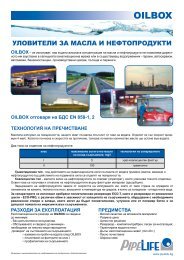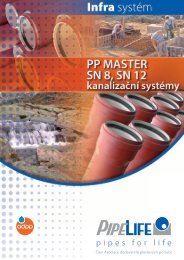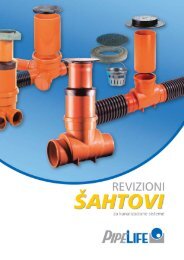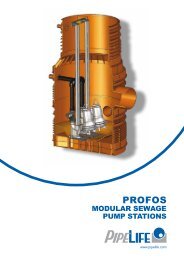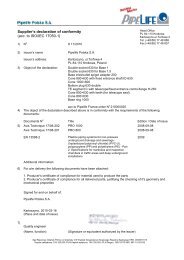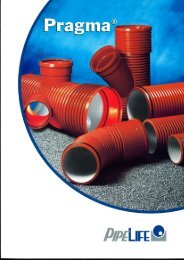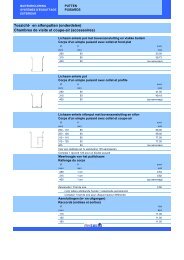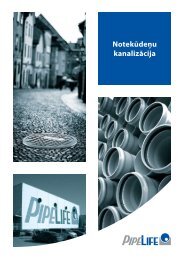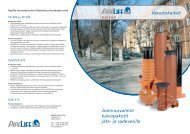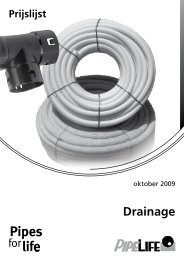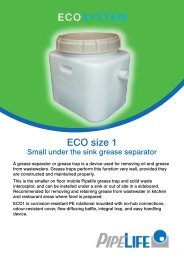PE Pipe Technical Catalogue (PDF) - Pipelife Norge AS
PE Pipe Technical Catalogue (PDF) - Pipelife Norge AS
PE Pipe Technical Catalogue (PDF) - Pipelife Norge AS
Create successful ePaper yourself
Turn your PDF publications into a flip-book with our unique Google optimized e-Paper software.
<strong>Pipe</strong>life <strong>Norge</strong> <strong>AS</strong><strong>PE</strong> CATALOGUE-SUBMARINE APPLICATIONS, PI<strong>PE</strong>LIFE NORGE <strong>AS</strong>, December 2002.A.5.1Internal air pressureThe internal pressure is dependent of loading from the concrete weights. Calculation of the loadingis described in A.4. The important parameter is the air filling rate, a a (ref. A.4-2).To obtain an air filled section in fig. A.5.1, which will balance the weight of the concrete collars, wemust apply an internal pressure (p) in the pipelines.p = a a ⋅ H A.5-1)p = internal pressure (mwc)a a = degree of air fillingH = water depth (m)As we see from formula A.5-1) the internal pressure is dependent of the water depth. This meansthat we have to increase the pressure as the depth increases. The compressor must have capacityto produce sufficient air against a pressure corresponding to maximum depth including pressure dropin the transmission pipelines.If we know the longitudinal section for a pipeline, we can calculate the balance pressure in eachpoint.This curve or table will be the basis for a successful installation.We have to use the pipe sections as reference regarding the length. For instance every 50 m of thepipe must be marked.Example 1Calculate the internal balance pressure for a Ø 500 mm <strong>PE</strong>80 SDR22 which has a loading degree ofconcrete weights corresponding to an air filling rate a a = 30 %.Assume the depths to be 10 m, 20 m and 30 m.Solution :We apply formula A.5-1) and get :P 10m = 0.3 ⋅ 10 m = 3 mwc = 0.29 barP 20m = 0.3 ⋅ 20 m = 6 mwc = 0.59 barP 30m = 0.3 ⋅ 30 m = 9 mwc = 0.88 barNotice that the internal pressure is independent of the pipe diameter.A.5.2Pulling forceThe pulling force in the end of the pipe is applied to control the pipe's position and to increasethe bending radius in the S configurations (ref. fig. A.5.2)If the loading percentage is less than 50 %, which normally is the case, the critical radius will beat the sea surface. Otherwise it will be at the seabed.To carry out a proper calculation of the sinking process is complicated and must be done bycomputer programs.However, there is a simple method to find an estimate for the pulling force. This method is based onthe chain link theory and is valid for deep water.Fig. A.5.2 shows the situation.Side 67 av 84



